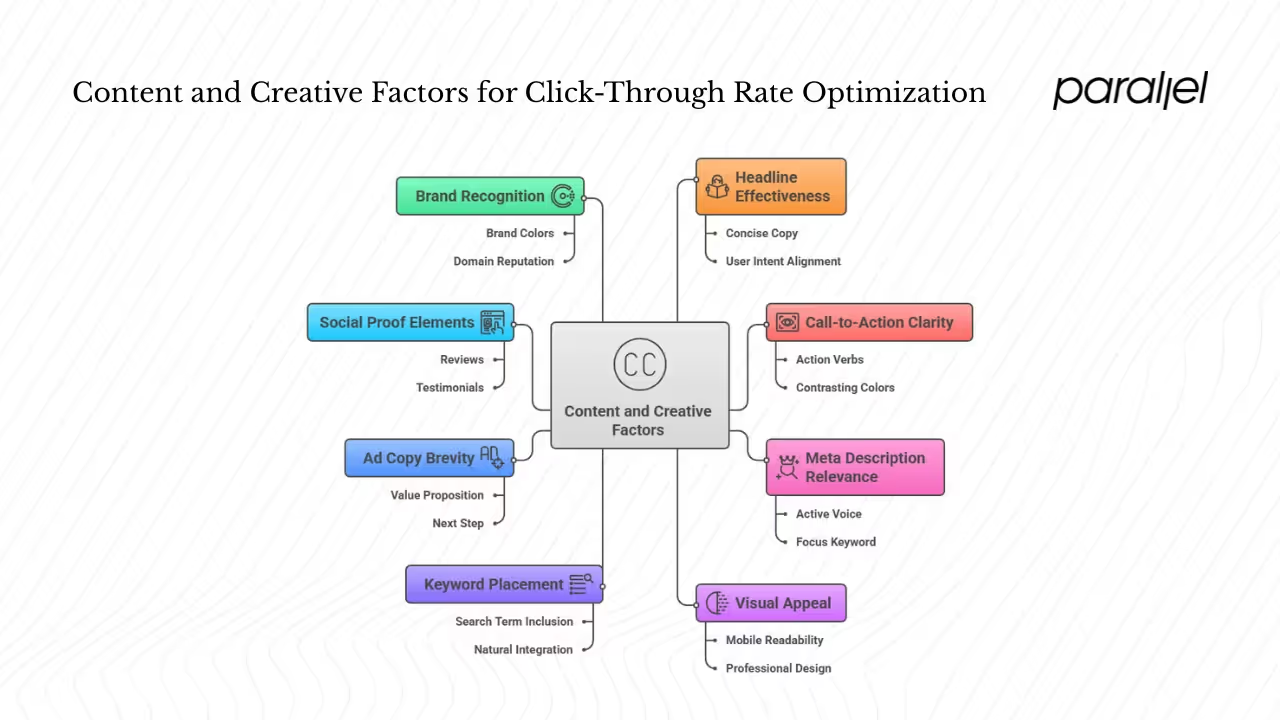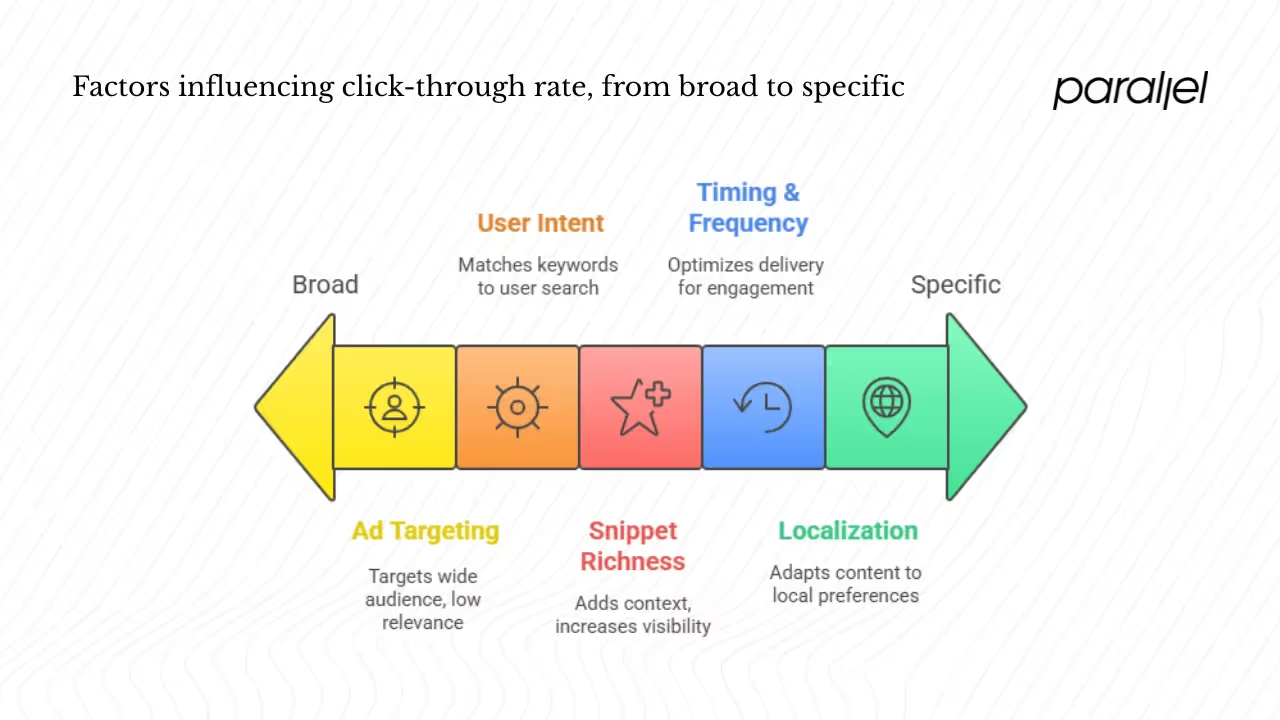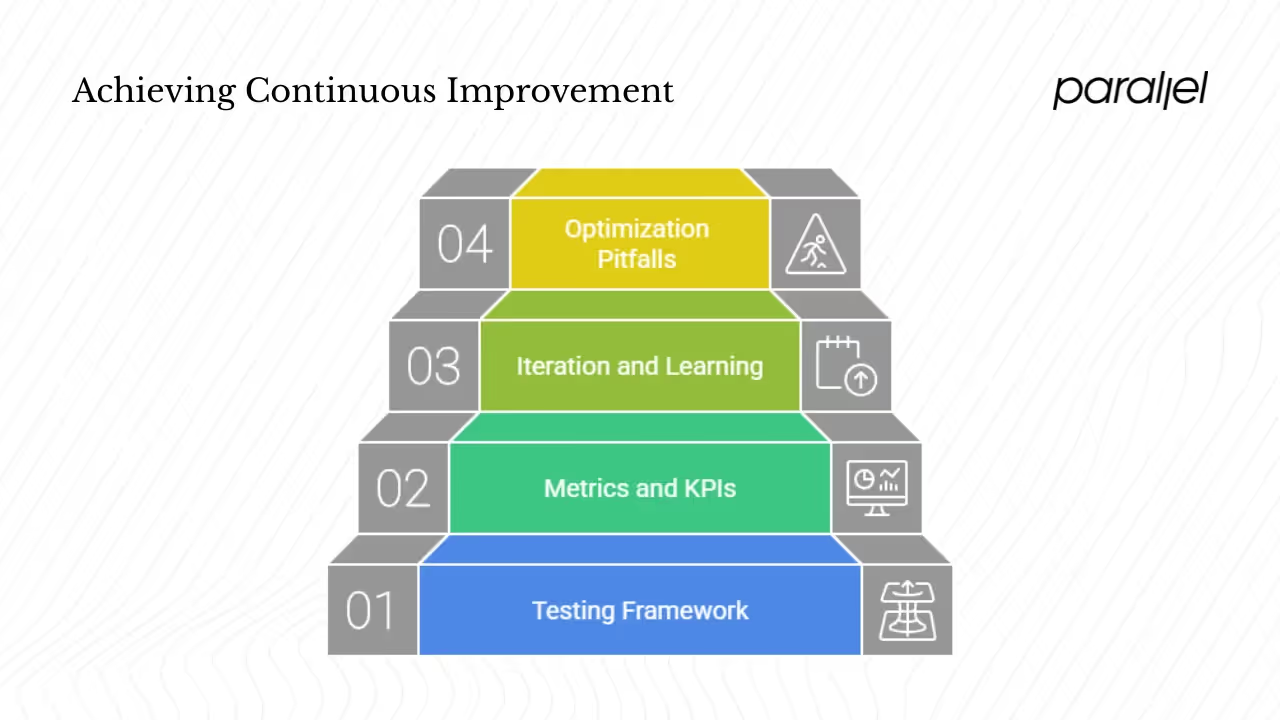Key Factors to Optimize Click‑Through Rate: Guide (2026)
Discover the key factors for optimizing click‑through rate, including compelling calls to action, clear messaging, and targeted design.

In product and growth teams, click‑through rate (CTR) is the clearest way to see whether people move from seeing something to acting on it. CTR is simply the number of clicks divided by the number of times something is shown. A startup’s ads, search snippets, email links or in‑product prompts all live or die by this ratio. The challenge is that there’s no magic number because benchmarks vary: Bloomreach’s 2025 review of millions of campaigns suggests a 2% CTR is “good” for many ads, though search ads often hit 5–10% while display banners average 0.5-1%. Email click rates hover around 2%. So rather than chasing one number, ask yourself: what factors are you going to focus on to optimize the click‑through rate? That question sits at the heart of this guide. We’ll look at what makes people click—your copy and design, who you target and when, and how to test your way to better results.
Setting the stage – know your baseline and context
Before changing anything, you need a baseline. Benchmarks vary by channel: In search advertising, the average CTR is about 3.17%, while display campaigns get roughly 0.46%. Bloomreach’s 2025 data shows that search ads can expect 5–10%, display banners about 2%, email marketing campaigns 2–3%, and social media ads such as Facebook and LinkedIn around 1%. MailerLite’s analysis of over three million campaigns found a median email click rate of 2%. These numbers set expectations, but they aren’t goals for every team. For an early‑stage startup, it’s often more useful to beat your last month’s performance than to chase industry averages.
Understand the funnel from impressions to clicks: a high number of impressions with a very low CTR often means poor targeting. Conversely, a very high CTR with few impressions may show you’re not reaching enough of the right audience. Context also matters. Organic search CTR affects your ranking because search engines adjust result positions based on clicks. Paid ads tie CTR into quality scores that influence cost and placement. In email, click‑through is a reliable engagement metric because privacy changes have made open rates noisy. In‑product prompts or notifications drive activation and retention.
In short, you’ll measure success differently for each channel, but every channel benefits from the same guiding question: what factors are you going to focus on to optimize the click‑through rate? Throughout this article we’ll group those factors into three zones: content and creative, targeting and intent, and the test‑and‑iterate loop.
Content and creative factors
Your message and its presentation drive the first decision: to click or not. Here are the elements you control.

1) Headline effectiveness
The headline or ad title is the hook. It should be clear, relevant and benefit‑driven. Long, rambling headlines get ignored; concise ones improve usability and attention. The Aela School notes that concise, scannable copy boosts usability by 124%. I’ve seen teams write three variants of a headline, each aligned to a different user intent. For search ads, include the actual search phrase so the user sees “this is what I’m looking for”. Ask yourself: what factors are you going to focus on to optimize the click‑through rate when it comes to your headline? Will you emphasise the benefit, the problem, or urgency? Write several options and A/B test them.
2) Call‑to‑action clarity
Once someone reads your headline or snippet, the call‑to‑action (CTA) tells them what to do next. According to HubSpot’s analysis of more than 330,000 calls‑to‑action, personalised CTAs outperform generic ones by 202%. Clear, benefit‑oriented phrases like “Get your free report” or “Start your trial” beat vague “Learn more” prompts. WiserNotify’s 2025 statistics show that placing the CTA above the fold produces 304% more clicks than burying it lower on the page, and reducing the number of CTAs to one increases conversions by 266%.
When designing CTAs, keep these guidelines in mind:
- Use action verbs and describe the benefits. “Get started” conveys more energy than “Submit”.
- Use contrasting colours and clean whitespace so the CTA stands out.
- Offer only one primary CTA per view to prevent analysis paralysis. Aela’s UX research explains that too many different CTAs confuse users, leading to indecision.
- Test placement. On some pages, a top‑of‑page CTA works best; on others, a bottom CTA after context might perform better.
3) Meta description relevance
In organic search, the meta description is your elevator pitch. It doesn’t directly influence search ranking, but search engines do adjust positions based on clicks, so an irrelevant description can harm you. Kinsta urges marketers to ensure meta descriptions clearly tell the user what they’ll get and encourage action. Use an active voice, include your focus keyword and end with a subtle call‑to‑action. If you run a product site, audit your top landing pages to ensure the description matches the page’s value and search intent.
4) Visual appeal
Humans process visuals faster than text, and high‑quality visuals can boost click interest. Bloomreach highlights that ad aesthetics and proper capitalization are qualitative requirements for high CTR. In emails, Omnisend recommends a single‑column layout, contrasting colour schemes and large tappable buttons to make CTAs easy to click. On landing pages, your design should look professional and trustworthy; avoid clutter and spammy graphics. Test versions with and without images, and make sure your content is readable on mobile screens—over 75% of email opens occur on mobile devices.
5) Keyword placement
Keywords aren’t just for search engines; they also signal relevance to users. For search ads, include the search term in your headline and body copy. Kinsta stresses that half of successful CTR is putting your link in front of the right people—the other half is matching the wording to user intent. If someone searches for “project management software for startups”, a headline like “Project management for growing teams” may underperform. Instead, mirror the term exactly. On landing pages and product descriptions, place the primary keyword early in the copy without stuffing; natural integration ensures readability and trust.
6) Ad copy brevity
People scan rather than read. Nielsen Norman Group studies show that only 16% of users read every word, while 79% scan. Keep your ad copy short and punchy. Focus on one value proposition and one next step. Use bullet points or line breaks to aid scanning. In my experience, replacing a dense paragraph with two lines and a list has lifted CTR by double digits.
7) Social proof elements
Trust signals make people more willing to click. Genesys Growth’s 2025 research shows that email campaigns including reviews see a 25% higher click‑through rate than those without. Real‑time social proof notifications—such as “2,000 people signed up this week”—can boost conversions by up to 98%. On landing pages and ads, include ratings, testimonials or logos of known customers. But don’t let these elements compete with your CTA; maintain a clear visual hierarchy.
8) Brand recognition
Even if you’re a new company, a consistent and professional look encourages trust. Bloomreach notes that domain reputation and ad aesthetics affect CTR. Use your brand colours, voice and logo consistently across ads and landing pages. Avoid ambiguous or unfamiliar domains in ads. If you’re using a third‑party landing page tool, map it to your own domain rather than a generic URL. This not only improves CTR but also helps with conversion because users aren’t second‑guessing the legitimacy of the link.
9) Personalization strategies
Personalization is one of the most effective ways to improve CTR. Bloomreach’s article describes how BrewDog tailored its messaging based on user behaviour and saw a 15.6% increase in email click‑through rates. Customising copy, visuals and offers to a user’s segment or past actions increases relevance and reduces friction. In email, dynamic content modules can change based on location, past purchases or user roles. In advertising, use remarketing and lookalike audiences to show messages to people who have already interacted with your product.
By carefully tuning these creative elements you can influence the first half of the click equation. Ask yourself again: what factors are you going to focus on to optimize the click‑through rate when you iterate on your headline, CTA, visuals or copy?
Targeting, intent and context factors
Beyond the message itself, you need to ensure the right people see it at the right time. These factors revolve around audience, intent and context.

1) Ad targeting accuracy
Broad targeting may yield lots of impressions but few clicks. Kinsta advises defining clear audience segments, excluding irrelevant audiences and using remarketing to reach higher‑intent users. Segment by location, demographics, behaviours and device. Compare CTRs across segments to spot mismatches—if one segment underperforms, refine your messaging or exclude that group. For early‑stage startups, building small, well‑defined audiences leads to learning faster than blasting everyone.
2) User intent matching
People click when what they see matches what they seek. In search and paid ads, this means aligning keywords, headlines, descriptions and landing pages. Kinsta recommends asking whether someone searching for a particular keyword expects content like yours. If the intent is informational, your ad should promise information rather than a product pitch. On product pages, deliver what the snippet promised; otherwise users will bounce and your quality scores and future CTR will decline. Always consider: what factors are you going to focus on to optimize the click‑through rate from an intent perspective?
3) Snippet richness
Rich snippets and ad extensions increase visibility. In organic search, structured data can add star ratings, breadcrumbs, product price or FAQs to your search result, making it more appealing. For ads, extensions like sitelinks, callouts and structured snippets provide extra context and can improve CTR. They also occupy more space, pushing competitors down. Audit how your pages appear on search engines and enable structured data markup where applicable.
4) Timing and frequency
What you show matters, but when you show it matters too. Moosend’s analysis of 10 billion emails found that Thursday and Tuesday generate the highest open rates, whereas Saturday sees the lowest. They also discovered that sending emails at 8–9 am delivers the best engagement and that open rates decline after 6 pm. A broader analysis across different platforms reveals that 9–10 am and 1–2 pm are peak times for openings. In fact, the consensus across studies is that 9–11 am is often the ideal window, with early afternoon also performing well. Conversely, sending messages between 7 pm and 5 am results in the worst performance.
For ads, look at time‑of‑day, day‑of‑week and device. Mobile users may be more active during commuting hours, while desktop users may click during work hours. Frequency also matters; overexposure leads to ad fatigue. Monitor your impression frequency per user and cap it to avoid diminishing returns.
5) Localization efforts
If your product serves multiple regions, language and cultural nuances influence CTR. Localizing keywords, headlines and visuals to match local preferences improves relevance. Use country‑specific domains or subdirectories for organic search. In ads, adjust currency, time formats and idioms. For example, an ad that performs well in the U.S. may not resonate the same way in India or Germany because expectations and norms differ. A generic approach may generate impressions but will rarely deliver good clicks.
Testing and optimization loop
Continuous improvement is the engine of performance. Without testing, you’re guessing.

1) Testing framework
Set up A/B or multivariate tests to evaluate changes in headlines, CTA text, visuals and targeting. Bloomreach and Kinsta both emphasise ongoing testing; even small changes can produce significant differences in CTR. For early‑stage startups, start with a hypothesis, such as “Adding customer count next to the CTA will increase click‑through rate by 10%.” Run the test on a small portion of traffic and compare results to the control. Use statistically significant sample sizes before rolling out winners.
2) Metrics and KPIs to track
Measure the full funnel: impressions → clicks → CTR → post‑click engagement → conversions. For email campaigns, track delivered emails, opens, clicks and click‑to‑open rate (CTOR) to see where drop‑offs occur. On landing pages, monitor bounce rate and time on page to ensure that clicks translate into engagement. For ads, evaluate CTR by keyword and audience segment. A high CTR with poor post‑click metrics may indicate misleading copy; a low CTR with good post‑click performance may suggest you need to improve targeting or creativity.
3) Iteration and learning
Document what you test, what you learned and what you’ll try next. Keep a test log with the hypothesis, change, outcome and next steps. Collaboration between design, product and marketing ensures insights travel upstream: a headline that performs well in a search ad might inform the language you use on the product page, and vice versa. Bring your team together to prioritise which factors you are going to focus on to optimize the click‑through rate in the next sprint.
4) Optimization pitfalls to avoid
Several traps can derail your optimisation work:
- Chasing clicks at the expense of quality. A catchy but misleading headline may spike CTR but lead to high bounce rates and low conversion.
- Testing too many variables at once. If you change headline, image and CTA simultaneously, you won’t know which factor drove the result.
- Judging results from small samples. Wait for sufficient impressions before concluding. Statistical significance matters.
- Neglecting post‑click experience. A great CTR loses value if your landing page is slow or confusing. Each second of page load time beyond two seconds can reduce conversion rates by 4.42%.
Putting it together – a practical checklist for startups
Use this checklist before launching an ad, email or landing page:
- ✅ Headline aligns with user intent and promise.
- ✅ Keyword placement. Include relevant keywords in the headline and body to signal relevance.
- ✅ Single, clear CTA. Benefit‑oriented, visible and placed for immediate visibility.
- ✅ Clean visuals. High‑quality images or icons, professional branding, mobile‑friendly.
- ✅ Meta description or snippet tailored to the query and benefit.
- ✅ Audience segment defined. Target persona, remarketing list or demographic group selected.
- ✅ Timing and frequency selected. Send messages during the 9–11 am or early afternoon window, adjust for time zones.
- ✅ Localization applied. Copy and visuals suit the locale, currency and cultural context.
- ✅ Social proof or brand trust included. Reviews, ratings or user counts near the CTA.
- ✅ Test plan defined. Variants, metrics and duration specified; control group established.
- ✅ Structured data or ad extensions enabled (organic search).
- ✅ Post‑click experience aligned with promise. The landing page loads fast, matches the ad’s value proposition, and requires minimal steps to complete the goal.
A short example: a SaaS startup ran an A/B test on its ad headline. Version A said “Project management tool for teams,” while version B added social proof: “Trusted by 10,000 teams—project management that scales.” The second variant, combined with a “Start your free trial” CTA, increased CTR from 1.5% to 2.3% in one week, a 53% improvement.
Conclusion
CTR isn’t a single magic trick—it’s the result of many small, deliberate choices across creative, targeting and experimentation. Startups don’t need to master everything at once; focus on the major elements—your headline, CTA and targeting—and track improvements over time. Personalisation, clear benefits and respecting user intent will always pay dividends. Ask yourself at every step what factors are you going to focus on to optimize the click‑through rate, and commit to learning through testing.
FAQ
1) How do you optimize click‑through rate?
Start by defining your audience, then craft a headline and CTA that speak directly to their intent. Use relevant keywords, provide a clear benefit and test variations. Ensure the landing page or follow‑up experience matches the promise. Finally, measure results and iterate.
2) What are the factors of click-through rate?
The factors covered in this guide include headline effectiveness, call‑to‑action clarity, meta description relevance, visual appeal, keyword placement, ad copy brevity, social proof elements, brand recognition, personalization strategies, ad targeting accuracy, user intent matching, snippet richness, timing and frequency, and localization efforts. Each of these influences whether someone chooses to click.
3) How do I improve my impression of click-through rate?
Improve the quality of your impressions by tightening targeting so your message reaches people who care. Then improve relevance through better headlines, visuals and meta descriptions. Enable rich snippets or ad extensions where possible. Send your emails or display your ads at peak engagement times such as 9–11 am or early afternoon.
4) How can I improve my expected CTR in paid search?
Expected CTR is part of Google Ads’ quality score. To raise it, align your ad copy and keywords to the search query, include the keyword in the headline, write compelling descriptions and ensure the landing page provides a good experience. High relevancy improves expected CTR and reduces cost.
5) Why focus on personalization?
Personalization increases relevance and trust. Bloomreach reports that personalised messages can raise click‑through rates by 15.6%. By tailoring copy, visuals and offers to a user’s segment or behaviour, you reduce friction and make clicking feel like the obvious next step.

.avif)











